MERCEDES-BENZ S-CLASS SALOON LONG 2020 Owners Manual
Manufacturer: MERCEDES-BENZ, Model Year: 2020, Model line: S-CLASS SALOON LONG, Model: MERCEDES-BENZ S-CLASS SALOON LONG 2020Pages: 609, PDF Size: 10.5 MB
Page 381 of 609
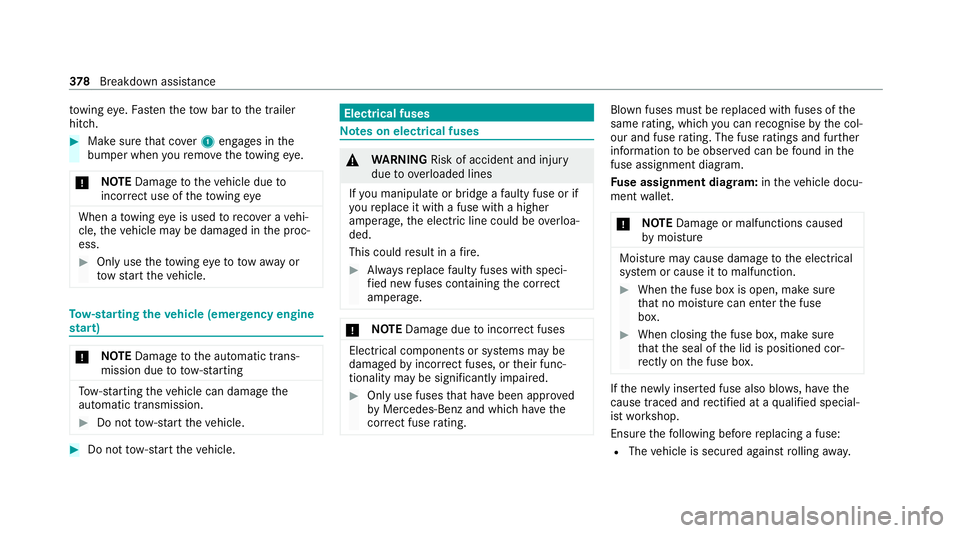
to
wing eye. Fasten theto w bar tothe trailer
hitch. #
Make sure that co ver1 engages in the
bumper when youre mo vetheto wing eye.
* NO
TEDama getotheve hicle due to
incor rect use of theto wing eye When a
towing eye is used toreco ver a vehi‐
cle, theve hicle may be damaged in the proc‐
ess. #
Only use theto wing eyeto to waw ay or
to w start theve hicle. To
w- starting theve hicle (eme rgency engine
st art) *
NO
TEDama getothe automatic trans‐
mission due to tow-starting To
w- starting theve hicle can damage the
automatic transmission. #
Do not tow- start theve hicle. #
Do not tow- start theve hicle. Electrical fuses
Note
s on electrical fuses &
WARNING Risk of accident and inju ry
due to ov erloaded lines
If yo u manipulate or bridge a faulty fuse or if
yo ure place it with a fuse with a higher
amperage, the electric line could be overloa‐
ded.
This could result in a fire. #
Alw aysre place faulty fuses with speci‐
fi ed new fuses conta iningthe cor rect
amperage. *
NO
TEDama gedue toincor rect fuses Electrical components or sy
stems may be
damaged byincor rect fuses, or their func‐
tionality may be significant lyimpaired. #
Only use fuses that ha vebeen appr oved
by Mercedes-Benz and which ha vethe
cor rect fuse rating. Blown fuses mu
stbe replaced with fuses of the
same rating, which you can recognise bythe col‐
our and fuse rating. The fuse ratings and fu rther
information tobe obser ved can be found in the
fuse assignment diagram.
Fu se assignment diag ram: intheve hicle docu‐
ment wallet.
* NO
TEDama geor malfunctions caused
by moisture Moisture may cause dama
getothe electrical
sy stem or cause it tomalfunction. #
When the fuse box is open, make sure
th at no moisture can enter the fuse
box. #
When closing the fuse box, make sure
th at the seal of the lid is positioned cor‐
re ctly on the fuse box. If
th e newly inser ted fuse also blo ws, ha vethe
cause traced and rectified at a qualified special‐
ist workshop.
Ensure thefo llowing before replacing a fuse:
R The vehicle is secured against rolling away. 378
Breakdown assis tance
Page 382 of 609

R
All electrical consumers are switched off.
R The ignition is switched off.
The electrical fuses are located in thefo llowing
fuse bo xes:
R Fuse box in the engine compartment on the
driver's side (/ page379)
R Fuse box on the driver's side of the cockpit
(/ page 381)
R Fuse box in the front passenger foot we ll
(/ page 381)
R Fuse box in the boot on theright-hand side
of theve hicle, when vie wed in the direction
of tr avel (/ page 381) Opening and closing
the fuse box in the
engine compa rtment Requ
irements:
R Obser vethe no tes on electrical fuses
(/ page 378).
R Have thefo llowing tools readily available:
- a dry clo th -
a sc rewdriver with an appropriate head
Opening
% Depending on theve hicle equipment, access
to the fuse box may be limited. Mercedes-
Benz recommends consulting a qualified
specialist workshop, e.g. a Mercedes-Benz
Service Centre. &
WARNING Risk of inju ryfrom using the
windscreen wipers while the engine bon‐
net is open
When the engine bonn etis open, and the
windscreen wipers are set in motion, you can
be trapped bythe wiper linkage. #
Alw ays switch off the windscreen wip‐
ers and ignition before opening the
engine bonn et. #
Release thero tary catches on co ver1 and
pull the co ver up and out. #
Remo veany existing moisture from the fuse
box using a dry clo th. Breakdown assis
tance 37 9
Page 383 of 609
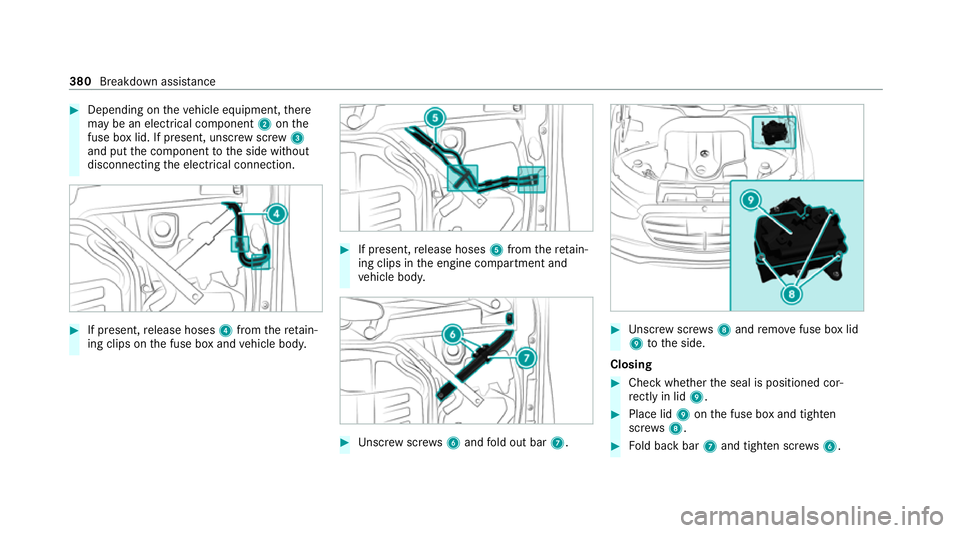
#
Depending on theve hicle equipment, there
may be an electrical component 2onthe
fuse box lid. If present, unscr ewscrew 3
and put the component tothe side without
disconnecting the electrical connection. #
If present, release hoses 4from there tain‐
ing clips on the fuse box and vehicle body. #
If present, release hoses 5from there tain‐
ing clips in the engine compartment and
ve hicle body. #
Unscr ew screws6 and fold out bar 7. #
Unscr ew screws8 and remo vefuse box lid
9 tothe side.
Closing #
Check whe ther the seal is positioned cor‐
re ctly in lid 9. #
Place lid 9onthe fuse box and tighten
scr ews8. #
Fold back bar 7and tigh ten scr ews6. 380
Breakdown assis tance
Page 384 of 609
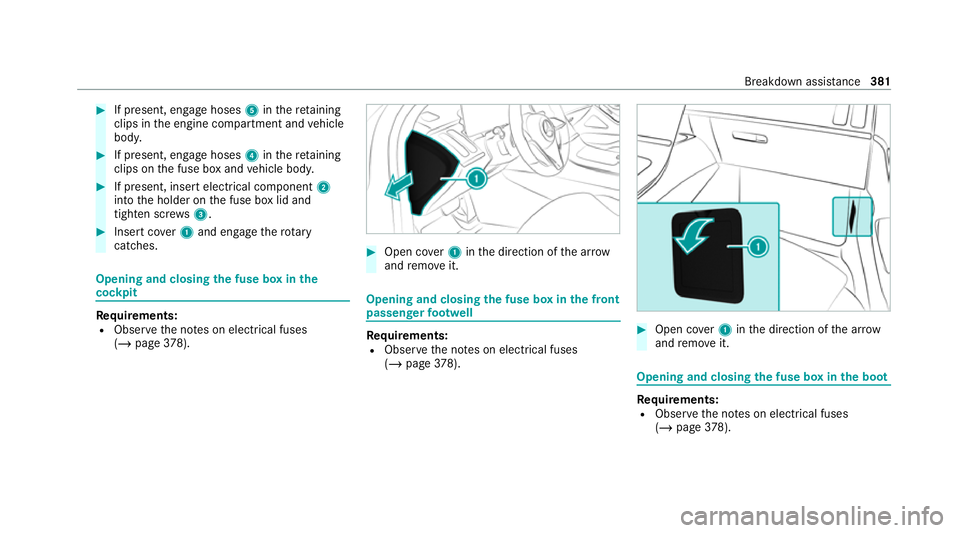
#
If present, engage hoses 5inthere tai ning
clips in the engine compartment and vehicle
body. #
If present, engage hoses 4inthere tai ning
clips on the fuse box and vehicle body. #
If present, insert electrical component 2
into the holder on the fuse box lid and
tighten scr ews3. #
Insert co ver1 and engage thero tary
catches. Opening and closing the fuse box in the
co
ckpit Re
quirements:
R Obser vethe no tes on electrical fuses
(/ page 378). #
Open cover1 inthe direction of the ar row
and remo veit. Opening and closing
the fuse box in the front
passenger foot we ll Re
quirements:
R Obser vethe no tes on electrical fuses
(/ page 378). #
Open cover1 inthe direction of the ar row
and remo veit. Opening and closing
the fuse box in the boot Re
quirements:
R Obser vethe no tes on electrical fuses
(/ page 378). Breakdown assis
tance 381
Page 385 of 609
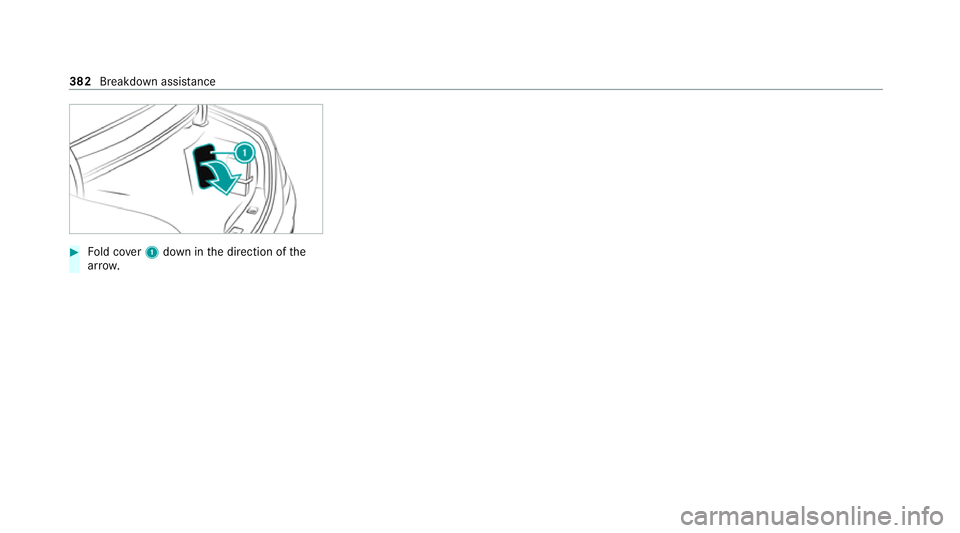
#
Fold co ver1 down in the direction of the
ar row. 382
Breakdown assis tance
Page 386 of 609
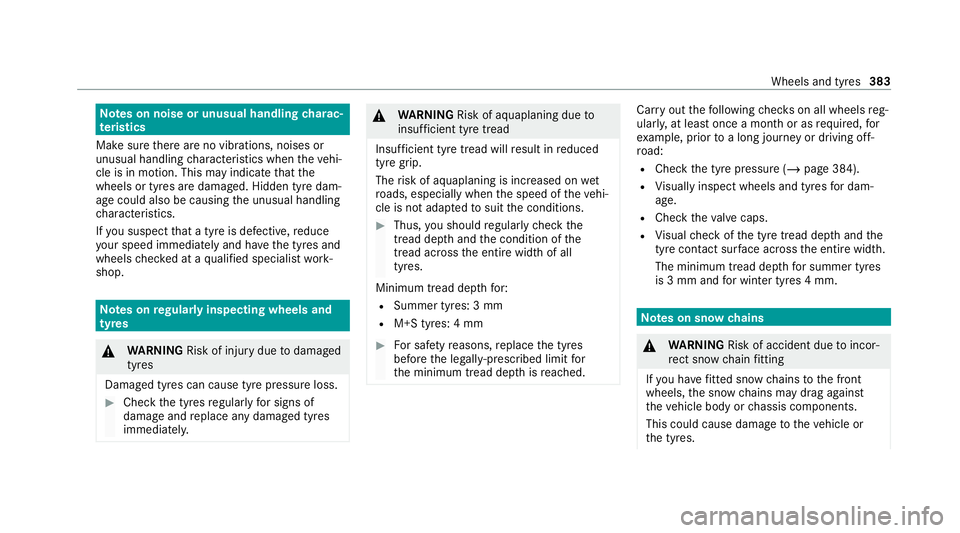
Note
s on noise or unusual handling charac‐
te rist ics
Make sure there are no vibrations, noises or
unusual handling characteristics when theve hi‐
cle is in motion. This may indicate that the
wheels or tyres are damaged. Hidden tyre dam‐
age could also be causing the unusual handling
ch aracteristics.
If yo u suspect that a tyre is defective, reduce
yo ur speed immediately and ha vethe tyres and
wheels checked at a qualified specialist work‐
shop. Note
s onregular lyinspecting wheels and
tyres &
WARNING Risk of inju rydue todamaged
tyres
Damaged tyres can cause tyre pressure loss. #
Check the tyres regularly for signs of
dama geand replace any damaged tyres
immediatel y. &
WARNING Risk of aquaplaning due to
insuf ficient tyre tread
Insu fficient tyre tread will result in reduced
tyre grip.
The risk of aquaplaning is increased on wet
ro ads, especially when the speed of theve hi‐
cle is not adap tedto suit the conditions. #
Thus, you should regularly check the
tread de pth and the condition of the
tread across the entire width of all
tyres.
Minimum tread dep thfor:
R Summer tyres: 3 mm
R M+S tyres: 4 mm #
For saf etyre asons, replace the tyres
before the legally-prescribed limit for
th e minimum tread dep thisreached. Car
ryout thefo llowing checks on all wheels reg‐
ularly, at least once a month or as requ ired, for
ex ample, prior toa long journey or driving off-
ro ad:
R Check the tyre pressure (/ page 384).
R Visually inspect wheels and tyres for dam‐
age.
R Check theva lve caps.
R Visual check of the tyre tread dep thand the
tyre contact su rface across the entire width.
The minimum tread dep thfor summer tyres
is 3 mm and for winter tyres 4 mm. Note
s on snow chains &
WARNING Risk of accident due toincor‐
re ct snow chain fitting
If yo u ha vefitted snow chains tothe front
wheels, the snow chains may drag against
th eve hicle body or chassis components.
This could cause damage totheve hicle or
th e tyres. Wheels and tyres
383
Page 387 of 609
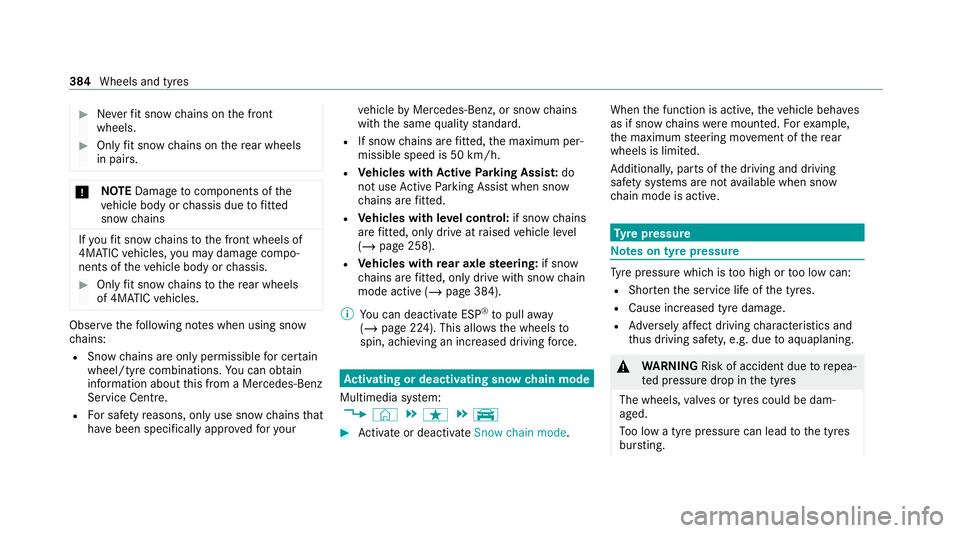
#
Neverfit snow chains on the front
wheels. #
Only fit snow chains on there ar wheels
in pairs. *
NO
TEDama getocomponents of the
ve hicle body or chassis due tofitted
snow chains If
yo ufit snow chains tothe front wheels of
4MATIC vehicles, you may damage co mpo‐
nents of theve hicle body or chassis. #
Onlyfit snow chains tothere ar wheels
of 4MATIC vehicles. Obser
vethefo llowing no tes when using snow
ch ains:
R Snow ch ains are on ly permissible for cer tain
wheel/tyre combinations. You can obtain
information about this from a Mercedes-Benz
Service Cent re.
R For saf etyre asons, on lyuse sn ow chainsthat
ha ve been specifically appr ovedfo ryo ur ve
hicle byMercedes-Benz, or snow chains
with the same quality standard.
R If sn ow ch ains are fitted, the maximum per‐
missible speed is 50 km/h.
R Vehicles with Active Park ing Assis t:do
not use Active Parking Assist when snow
ch ains are fitted.
R Vehicles with le vel control: if snowchains
are fitted, only drive at raised vehicle le vel
( / page 258).
R Vehicles with rear axle steering: if snow
ch ains are fitted, only drive wi thsnow chain
mode active (/ page 384).
% You can deactivate ESP ®
to pull away
( / page 224). This allo ws the wheels to
spin, achieving an increased driving forc e. Ac
tivating or deactivating sn owchain mode
Multimedia sy stem:
4 © 5
ß 5
y #
Activate or deacti vate Snow chain mode. When
the function is active, theve hicle beha ves
as if sn ow chainsweremounted. Forex ample,
th e maximum steering mo vement of there ar
wheels is limited.
Ad ditionally, parts of the driving and driving
saf ety sy stems are not available when sn ow
ch ain mode is active. Ty
re pressure Note
s on tyre pressure Ty
re pressure which is too high or too low can:
R Shor tenth e service life of the tyres.
R Cause increased tyre damage.
R Adversely af fect driving characteristics and
th us driving saf ety, e.g. due toaquaplaning. &
WARNING Risk of accident due torepea‐
te d pressure drop in the tyres
The wheels, valves or tyres could be dam‐
aged.
To o low a tyre pressure can lead tothe tyres
bur sting. 384
Wheels and tyres
Page 388 of 609
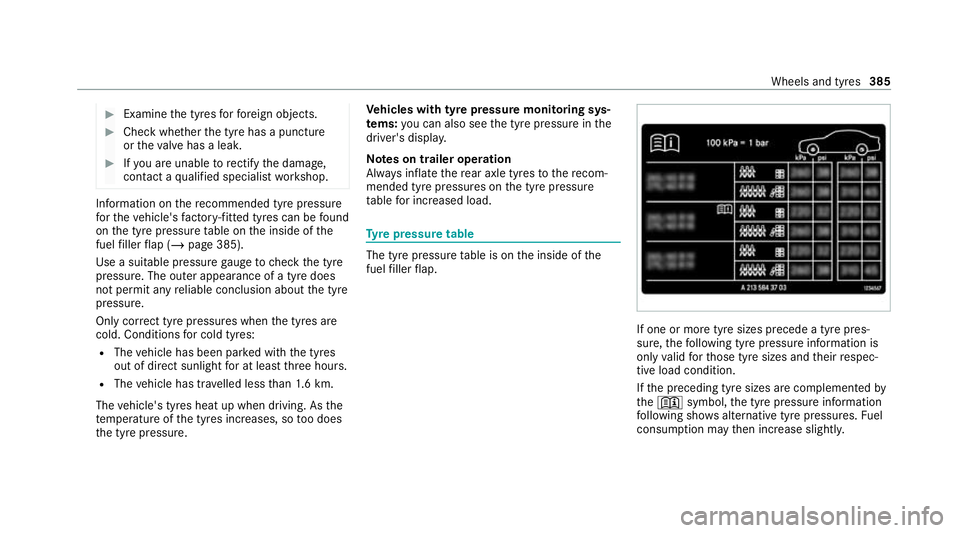
#
Examine the tyres forfo re ign objects. #
Check whe ther the tyre has a puncture
or theva lve has a leak. #
Ifyo u are unable torectify the damage,
conta ct aqualified specialist workshop. Information on
there commended tyre pressure
fo rth eve hicle's factor y-fitted tyres can be found
on the tyre pressure table on the inside of the
fuel filler flap (/ page 385).
Use a suitable pressure gauge tocheck the tyre
pressure. The outer appearance of a tyre does
not permit any reliable conclusion about the tyre
pressure.
Only cor rect tyre pressures when the tyres are
cold. Conditions for cold tyres:
R The vehicle has been par ked with the tyres
out of direct sunlight for at least thre e hours.
R The vehicle has tr avelled less than 1.6 km.
The vehicle's tyres heat up when driving. As the
te mp erature of the tyres increases, so too does
th e tyre pressure. Ve
hicles with tyre pressure monitoring sys‐
te ms: you can also see the tyre pressure in the
driver's displa y.
Note s on trailer operation
Alw ays inflate there ar axle tyres tothere com‐
mended tyre pressures on the tyre pressure
ta ble for increased load. Ty
re pressure table The tyre pressure
table is on the inside of the
fuel filler flap. If one or more tyre sizes precede a tyre pres‐
sure, thefo llowing tyre pressure information is
only valid forth ose tyre sizes and their respec‐
tive load condition.
If th e preceding tyre sizes are complemented by
th e+ symbol, the tyre pressure information
fo llowing sho wsalternative tyre pressures. Fuel
consum ption may then increase slightl y. Wheels and tyres
385
Page 389 of 609
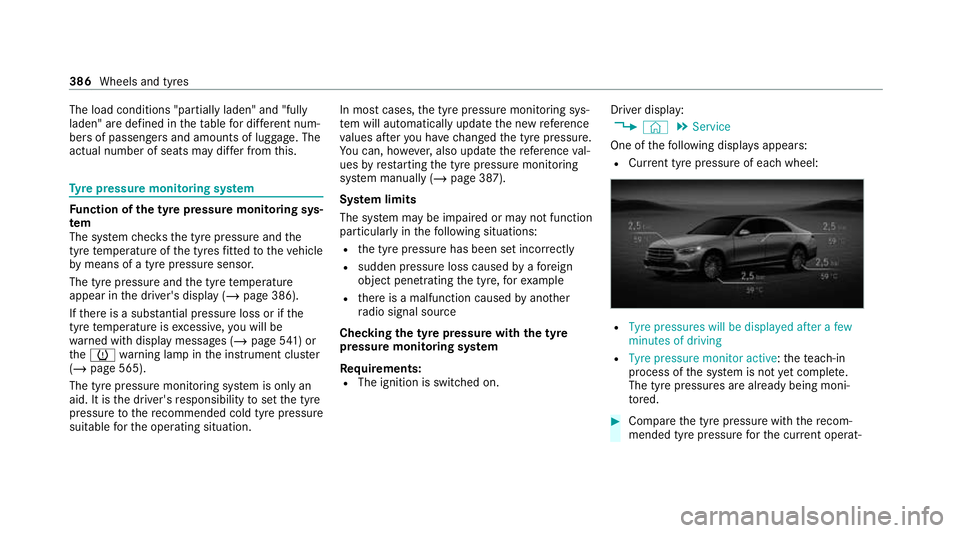
The load conditions "partially laden" and "fully
laden" are defined in
theta ble for dif fere nt num‐
be rs of passengers and amounts of luggage. The
actual number of seats may dif fer from this. Ty
re pressure moni toring sy stem Fu
nction of the ty repressure moni toring sys‐
tem
The sy stem checks the tyre pressure and the
tyre temp erature of the tyres fitted totheve hicle
by means of a tyre pressu resensor.
The tyre pressure and the tyre temp erature
appear in the driver's display (/ page 386).
If th ere is a subs tantial pressure loss or if the
tyre temp erature is excessive, you will be
wa rned with display messages (/ page541) or
th eh warning lamp in the instrument clus ter
( / page 565).
The tyre pressure monitoring sy stem is only an
aid. It is the driver's responsibility toset the tyre
pressure tothere commended cold tyre pressure
suitable forth e operating situation. In most cases,
the tyre pressure monitoring sys‐
te m will auto matically update the new refere nce
va lues af teryo u ha vechanged the tyre pressure.
Yo u can, ho wever,also update there fere nce val‐
ues byrestarting the tyre pressure monitoring
sy stem manually (/ page 387).
Sy stem limits
The sy stem may be impaired or may not function
particularly in thefo llowing situations:
R the tyre pressure has been set incor rectly
R sudden pressure loss caused byafo re ign
object penetrating the tyre, forex ample
R there is a malfunction caused byano ther
ra dio signal source
Checking the ty repressure with the tyre
pressure moni toring sy stem
Requ irements:
R The ignition is switched on. Driver display:
4 © 5
Service
One of thefo llowing displa ysappears:
R Cur rent tyre pressure of ea chwheel: R
Tyre pressures will be displayed after a few
minutes of driving
R Tyre pressure monitor active: thete ach-in
process of the sy stem is not yet compl ete.
The tyre pressures are already being moni‐
to re d. #
Compare the tyre pressure with there com‐
mended tyre pressure forth e cur rent operat‐ 386
Wheels and tyres
Page 390 of 609
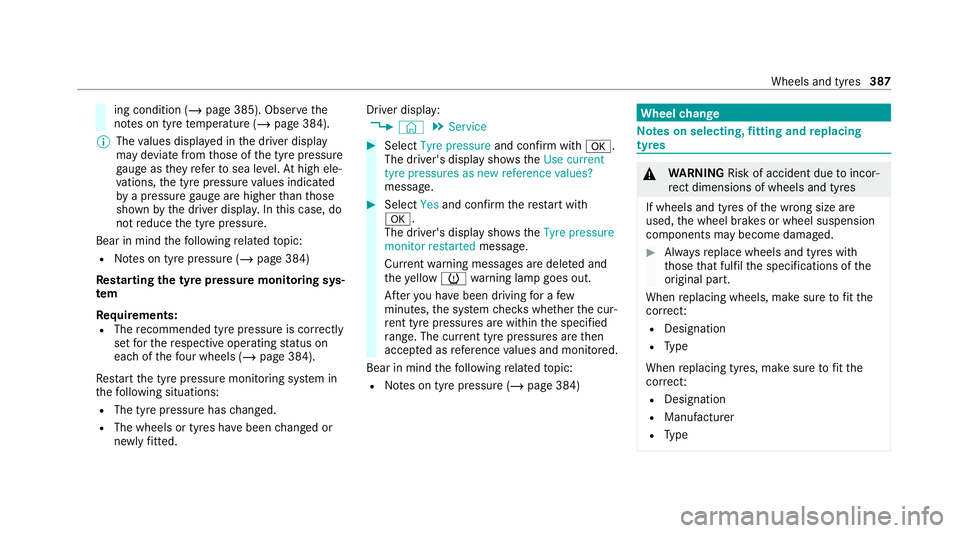
ing condition (/
page 385). Observethe
no tes on tyre temp erature (/ page 384).
% The values displa yed in the driver display
may deviate from those of the tyre pressure
ga uge as they referto sea le vel.At high ele‐
va tions, the tyre pressure values indicated
by a pressure gauge are higher than those
shown bythe driver displa y.In this case, do
not reduce the tyre pressure.
Bear in mind thefo llowing related topic:
R Notes on tyre pressure (/ page 384)
Re starting the ty repressure moni toring sys‐
tem
Re quirements:
R The recommended tyre pressure is cor rectly
set forth ere spective operating status on
each of thefo ur wheels (/ page 384).
Re start the tyre pressure monitoring sy stem in
th efo llowing situations:
R The tyre pressure has changed.
R The wheels or tyres ha vebeen changed or
newly fitted. Driver display:
4 © 5
Service #
Select Tyre pressure and confirm wi tha .
The driver's display sho wstheUse current
tyre pressures as new reference values?
message. #
Select Yesand confi rmthere start with
a.
The driver's display sho wstheTyre pressure
monitor restarted message.
Cur rent wa rning messages are dele ted and
th eye llow h warning lamp goes out.
Af teryo u ha vebeen driving for a few
minutes, the sy stem checks whe ther the cur‐
re nt tyre pressures are wi thin the specified
ra nge. The cur rent tyre pressures are then
accep ted as refere nce values and monitored.
Bear in mind thefo llowing related topic:
R Notes on tyre pressure (/ page 384) Wheel
change Note
s on selecting, fitting and replacing
tyres &
WARNING Risk of accident due toincor‐
re ct dimensions of wheels and tyres
If wheels and tyres of the wrong size are
used, the wheel brakes or wheel suspension
components may become damaged. #
Alw aysre place wheels and tyres with
th ose that fulfil the specifications of the
original part.
When replacing wheels, make sure tofit the
cor rect:
R Designation
R Type
When replacing tyres, make sure tofit the
cor rect:
R Designation
R Manufactu rer
R Type Wheels and tyres
387